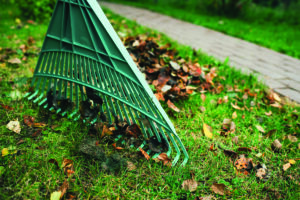
A thick layer of leaves left on a lawn inhibits growth, invites disease and encourages rodents. Compost the raked leaves or use shredded leaves as mulch (only an inch deep) around perennials — after the first frost.
Fall officially starts on Sept. 22, and with it traditionally comes a long “to-do” list of clean-up chores.
Gardeners, and nature-lovers in particular, are learning that list is better cut to a minimum for the sake of wildlife
Your tendency may be to rake every leaf, prune every plant and pull every finished annual for a pristine landscape.
However, all this effort may do more harm than good, since many beneficial insects — such as lady beetles, bumblebees, millipedes and spiders — depend on leaf litter for food and shelter during the winter.
Moths and butterflies overwinter, in the form of eggs or chrysalises, in leaf litter or on stems.
Some insects such as native bees spend the winter inside hollow stems.
Birds, squirrels, turtles and chipmunks forage in leaf litter for food and enjoy seeds of sunflowers, coneflowers, black-eyed Susans, zinnias and such.
So when should you do a more thorough clean up?
Different species emerge at different times, depending partly on the weather.
If you must get an early start in spring, consider piling last year’s dead stems in a corner somewhere, rather than composting right away, so that insects still have a chance to emerge from those stems.
There. Your to-do list has been trimmed to these chores:
• Clean out the vegetable garden of spent plants so you can get an early start with vegetables next spring. Dispose of diseased or insect-infested plants; compost healthy materials.
Consider planting a cover crop where the vegetables were.
• Clean out the rose garden if your roses suffered from black spot or other diseases.
• Obviously, you should remove invasive plants, or at least cut off the seed heads, to prevent them from spreading.
• Mow the grass one last time — at the regular height, not shorter — once it has finished growing.
• Fertilize cool-season grass. Grass puts energy into root growth in the fall, which means healthier, more resilient plants. Spring application encourages leaf growth, which you then have to mow.
• Water any new plantings. Don’t depend on Mother Nature to get them through the winter.
• Rake leaves off the lawn, or better yet, mow over them with a mulching mower and leave them as fertilizer. A thick layer of leaves left on a lawn inhibits growth, invites disease and encourages rodents. Compost the raked leaves or use shredded leaves as mulch (only an inch deep) around perennials — after the first frost. Remember that burning leaves is prohibited in some places. Check with your local fire department or government before lighting them up.
• Sanitize containers. Dump soil and plants into the compost pile and scrub flower pots. Tools will need to be cleaned also, but can wait another month.
Fall is also a good time for dividing perennials, transplanting plants to a better location or planting new perennials, trees and shrubs.
It’s also time to plant spring bulbs such as tulips and daffodils.
Tropicals such as caladium, cannas, dahlias, elephant ears and gladiolus may not survive a hard freeze but can be dug in fall and replanted in spring.



